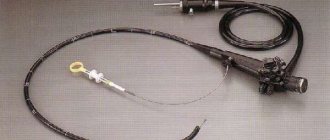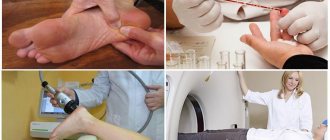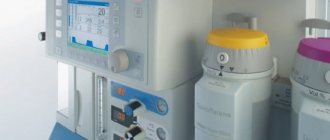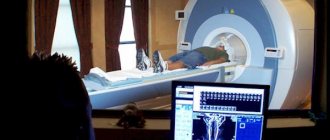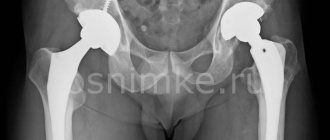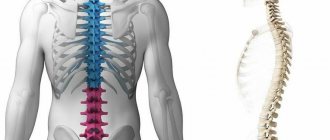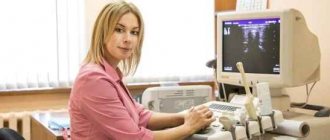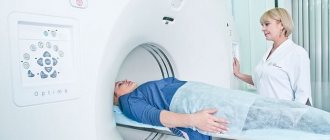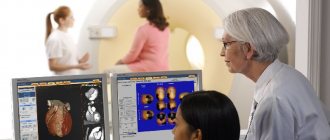Causes of pain
The consequences of the procedure for endoscopic examination of the stomach include painful sensations of moderate intensity, localized in the throat and upper abdomen, resulting from mechanical irritation of the mucous membrane. Usually they do not cause discomfort to the patient and go away on their own a few hours after the procedure.
Longer pain in the throat is associated with various complications that could occur during the procedure; they arise due to:
The immediate causes of long-term pain in the pharynx and larynx include injuries to the mucous membrane and local inflammatory reactions.
Mechanical damage
The most common cause of discomfort in the throat is damage to the delicate mucous membrane of the oropharynx and larynx with an endoscopic tube. This happens when:
- Use of old equipment (large diameter endoscopic tubes).
- Rough actions of a specialist.
- Failure of the patient to comply with medical recommendations (improper behavior during the examination, excessive physical activity).
- Excessive use of local anesthetic drugs in patients with intolerance.
- Carrying out diagnostic manipulation in the presence of contraindications.
As a result, microtraumas - erosions, ulcers, hematomas - can occur on the delicate mucous membrane. Usually they do not pose any particular danger and heal within a few days, however, if the pain during gastroscopy continues for more than a day, it is important to consult a specialist to determine the cause and prescribe treatment.
To eliminate pain and prevent infectious complications, patients after fibrogastroduodenoscopy are prescribed gargling with local antiseptics (Chlorhexidine, Miramistin) and resorption of lozenges (Stopangin, Strepsils).
Inflammatory reactions
Another common reason for a sore throat after FGDS is the development of an inflammatory process (pharyngitis, laryngitis, tracheitis). Weakened patients with a predisposition to upper respiratory tract diseases may also experience sore throat.
Symptoms of the development of infectious pathologies after endoscopic examination are:
- Sore throat, sore throat, itching.
- Discomfort when swallowing.
- Redness of the pharynx, the appearance of purulent films with sore throat.
- Swelling of the mucous membranes of the throat.
- Increased body temperature.
- Symptoms of general intoxication are weakness, lethargy, headaches.
In this case, the sore throat after gastroscopy does not go away, but only increases after a few days. If you suspect the development of an inflammatory process in the ENT organs, you should consult a general practitioner or otolaryngologist for diagnosis and treatment (local antiseptics, anesthetics, antibacterial drugs).
Possible complications
The main failure is considered to be the complete inability to adequately conduct FGDS. There are the following 3 main reasons:
- Improper preparation of the patient for an endoscope (foreign body) in the gastrointestinal tract, leading to the following consequences:
- Provocation of psychomotor agitation;
- Strong gag reflex;
- Choking (impaired breathing until it stops completely - apnea);
- Regurgitation (backflow) of mucus/saliva into the airways;
- Improper preparation of the digestive tract itself (there is no food, blood, liquid, which not only impairs vision, but also contributes to the reflux of contents into the respiratory tract);
- Insufficient qualifications or experience of the endoscopist, lack of technical capabilities (for example, there are no instruments of the required diameter, which forces the use of inappropriate ones).
The most common complications of FGDS include the following:
- Damage to the laryngopharynx area of varying depth. Leads to a change in phonation, the addition of a secondary infection (usually purulent in nature);
- Injury to the wall of the esophagus, stomach or duodenum. May be accompanied by the development of massive bleeding, perforation of hollow organs;
- Formation of esophageal-tracheal fistulas;
- Mediastinitis;
- Peritonitis;
- Formation of abscesses in the retroperitoneal space;
- Mediastinal emphysema;
- Emphysema of the neck, subcutaneous.
Now anyone has the right to undergo an endoscopic examination privately without permission. However, a person cannot adequately balance the benefits and risks in order to avoid the development of complications, including in the long term. Therefore, FGDS should be prescribed exclusively by the attending physician.
Contraindications to the procedure
Many patients are interested in “is it possible to do FGDS for a cold?” Experts identify the following contraindications for endoscopic examination of the gastrointestinal tract:
- Severe arterial hypertension, crisis.
- Stroke, heart attack in the acute period.
- Cardiovascular, respiratory failure.
- Arrhythmias, aortic or cardiac aneurysm.
- Severe mental pathologies.
All this is a contraindication to planned diagnostic manipulation. If it is necessary to conduct an emergency FGDS in case of suspected gastric bleeding, there are no prohibitions on performing the manipulation.
A cold is not a contraindication to gastroscopy, however, in the presence of severe catarrhal symptoms (nasal congestion, coughing, sneezing), it is better to postpone diagnosis until the patient has completely recovered. Inflammatory diseases of the nasal mucosa, pharynx, larynx and trachea make the procedure difficult, and in rare cases can be complicated by reflex laryngospasm with subsequent development of respiratory failure.
Testing without swallowing the tube and probe
If it is absolutely impossible to perform a classic gastroscopy, if the patient has contraindications, there is an alternative method of visual examination of the gastrointestinal tract. This is a capsule FGDS - the patient swallows not a tube, but a small chamber in the form of a capsule. It sequentially passes through all parts of the gastrointestinal tract and leaves the body naturally. The data recorded by the camera is then transferred to a computer where the doctor can study it.
This lightweight method is no less informative than classic gastroscopy; it allows you to study not only the upper gastrointestinal tract, but also the entire intestine from the inside. However, it is not performed on all patients. The cost of such a study is very high - together with the capsule itself, the price of the procedure is within 50 thousand rubles.
As with classical gastroscopy, there are several contraindications:
- swallowing disorder;
- installed pacemaker;
- epilepsy;
- intestinal obstruction.
The preparation required is the same as for conventional FGDS. The capsule passes through the entire gastrointestinal tract in 12-14 hours, so the test result is issued the next day.
Capsule FGDS
Gastroscopy for colds
So is it possible to do gastroscopy if your throat hurts? If you have a cold, an urgent diagnostic procedure is not contraindicated, but a number of precautions should be observed.
Before the manipulation, you should treat the mucous membrane of the throat and pharynx with a solution of local anesthetic (to reduce pain) and drip vasoconstrictors into the nose to reduce a runny nose and improve nasal breathing. After FGDS, such patients are advised to use local antiseptics in the form of sprays and rinses, as well as antibiotic therapy to prevent the addition of a bacterial infection.
To speed up the recovery of the mucous membrane damaged during FGDS, doctors recommend following a gentle diet for several days (refusing spicy, spicy, excessively hot foods), gargling with a chamomile solution and drinking herbal teas that soothe a sore throat and promote its rapid healing.
Cough and shortness of breath - it could be GERD
Pulmonary manifestations of reflux disease cause problems for all patients. People over 40 years of age are more prone to them, but exceptions are possible. Symptoms resemble bronchial asthma, aspiration pneumonia or obstructive bronchitis:
- prolonged cough that does not go away within several days and cannot be treated with antibacterial substances;
- a feeling of lack of air, a person begins to choke for no apparent reason;
- There is rarely shortness of breath.
The torment lasts endlessly; conventional drugs prescribed for these pathologies are not effective. Pulmonologists deal with such patients and do not find anything that would confirm one of the diseases of the respiratory system.
How to distinguish gastroesophageal reflux disease in this case?
- The cough almost always occurs while lying down, immediately after eating or before eating. At this moment, gastric contents are refluxed into the esophagus (reflux), part of which enters the bronchi - their spasm begins.
- The cough often appears at night and is suffocating in nature; it can stop when standing or sitting.
For differential dosage, it is enough to carry out a number of important examinations.
- General clinical: a blood test that explains whether there is an infection in the body, which excludes or confirms the diagnosis of pneumonia. If a large number of eosinophils are present in the blood, a disease such as bronchial asthma can be assumed.
- X-ray will show whether there is pneumonia.
- A spirographic study will help determine the presence of bronchial obstruction.
- The most informative and revealing study is FGDS (fibrogastroduodenoscopy), which can detect changes in the mucous membrane of the esophagus and how well its round muscle, the sphincter, functions.
Do not forget that any of the pulmonary diseases can develop along with GERD.
All about indications and contraindications for planned and emergency FGDS
Fibrogastroduodenoscopy or FGDS is an instrumental endoscopic method for examining the digestive tract, which is used to diagnose many gastroenterological diseases. In patients, this procedure is better known as gastroscopy of the stomach, but the scope of the study is not limited to this organ.
Indications for gastroscopy may include pathologies of the esophagus, stomach and duodenum, among which there are dozens of diagnoses. There are also extensive contraindications to FGDS, which can be associated both with problems of the digestive tract and nearby organs. Often, pathologies of organs and their systems that are located remotely and, at first glance, have nothing to do with the digestive system, can become contraindications for gastroscopy.
Advantages and disadvantages
Fibrogastroscopy has a number of positive and negative aspects, taking into account which the need for it is determined.
The pros and cons of gastroscopy are presented in the table:
| Advantages | Flaws |
|
|
Indications for planned gastroscopy
A routine FGDS examination is prescribed when the patient has symptoms of gastroenterological diseases, but there is no threat to life. Most often, symptoms such as:
- pain in the upper abdomen in the triangle between the costal arches (epigastric region);
- heartburn or sour belching;
- a feeling of heaviness, fullness in the stomach after eating a small amount of food, or a sucking sensation in the stomach even after a large meal;
- nausea with the urge to vomit or single vomiting;
- bloating, flatulence, colic in the navel area.
Also considered indications are decreased appetite, which has led to weight loss, or weight loss while maintaining caloric intake and diet.
Matters are not entirely of the heart
Typical extraesophageal manifestations of GERD include cardiac pain. Often, manifestations of reflux are mistaken for angina pectoris (it is also called angina pectoris). This disease develops as a result of a lack of adequate blood supply to the heart muscle. Pain in the heart area appears when it “does not have enough oxygen.”
Why are these two diseases confused?
- Heartburn from reflux disease often mimics heart pain. A person cannot always clearly differentiate whether it is a burning sensation in the esophagus or heart problems.
- The esophagus is located next to the heart, and in older people these two pathologies occur together - this is the main reason for the difficulties of diagnosis.
These diseases can be distinguished with careful observation:
- during the development of angina pectoris, pain begins after physical exertion and with severe emotional shock;
- heartburn and discomfort with GERD develops during or after eating, especially when bending over or lying down;
- pain in the heart is relieved with nitroglycerin, and in case of digestive system disease - with antacids and proton pump inhibitors;
- reflux disease will not show specific changes on the cardiogram.
Indications for emergency gastroscopy
Indications for emergency gastroscopy are acute conditions that require immediate diagnosis and, if possible, therapeutic intervention. They are usually accompanied by uncontrollable vomiting mixed with blood, extremely severe pain in the epigastrium, and the inability to swallow even liquid food.
The absolute indications for emergency FGDS include:
- entry of foreign bodies into the esophagus and stomach, which can cause rupture or puncture of the walls of the digestive organs, or cause blockage of the gastrointestinal tract;
- gastric bleeding that needs to be stopped urgently by tamponing, ligating or coagulation of bleeding vessels;
- acute complications of peptic ulcer with bleeding and suspected perforation of the organ walls.
Important! Such conditions often require ignoring existing contraindications to FGDS.
Types of fibrogastroscopy
It is customary to distinguish 2 types of gastroscopic examination:
- planned;
- emergency.
Planned
This includes all procedures to clarify the diagnosis in the following cases:
- digestive disorders;
- frequent pain in the abdomen or epigastric region;
- clarification of the etiology of anemia (hidden gastric bleeding may be the cause);
- control of treatment of stomach diseases;
- preventive examination to identify early pathologies of the digestive system.
Preparation for a planned FGDS is always carried out in advance, taking into account the general health of the patient and the presence of relative or absolute contraindications.
Emergency
There are cases when, in order to preserve health or save a person’s life, it is necessary to perform FGS on an emergency basis, without prior preparation of the patient.
Such cases include:
- Entry of a foreign body into the stomach or esophagus. Foreign objects are removed through the esophagus using a gastroscope.
- Stomach bleeding. FGDS allows not only to determine the cause and intensity of blood loss, but also, in some cases, to stop bleeding through a fiberscope.
- Intraoperative FGS, which allows identifying a pathological focus before emergency surgery. In some cases, it is possible to avoid surgery and eliminate the pathology using a gastroscope.
It is noteworthy that even myocardial infarction and other acute cardiac pathologies do not serve as an absolute contraindication for emergency intervention: a council of 3 specialists can authorize gastroscopic intervention for stroke, heart attack and other serious conditions, if this is necessary to save the patient’s life.
Unlike planned gastroscopy, emergency gastroscopy has almost no contraindications; it is only inappropriate to perform it in the agonal and preagonal state of the patient.
Constant contraindications for FGDS
Absolute or permanent contraindications to FGDS are diseases and pathological conditions that are categorically incompatible with endoscopic interventions. They cannot be performed due to the high risk of complications. Doctors call such contraindications to gastroscopy:
- severe decompensated pathologies of the heart and lungs - early post-stroke or post-infarction period;
- pulmonary or heart failure in the acute or decompensated stage;
- acute hypertensive crisis and the first day after an exacerbation of an attack;
- diseases of the hematopoietic system, which are accompanied by a decrease in blood clotting.
A significant contraindication to the examination is displacement of the esophagus due to severe curvature of the spine, significant hypertrophy of the thyroid gland, as well as aortic aneurysm and mediastinal diseases. In this case, there is a high risk of injury to the esophageal tube by the gastroscope.
An absolute contraindication to gastroscopy is an attack of bronchial asthma. Under conditions of hypoxia, the patient is unable to control his behavior. In addition, the gastroscope tube makes breathing difficult even in healthy patients. If an examination is carried out in the presence of this contraindication, there is a high probability of death of the patient due to asphyxia.
Also, gastroenterologists do not recommend performing FGDS on patients in old age, when the patient has numerous changes in body functions. Most of these diseases are contraindicated and therefore require special assessment by a doctor. Even if there are indications for gastroscopy, for elderly patients the doctor selects another method: ultrasound, virtual gastroscopy, CT or MRI.
Other complications of FGDS
In addition to pain, other complications may occur after FGDS:
- Bloating. This is due to the swallowing of a large amount of air during insertion of the endoscope.
- Painful sensations along the esophagus and in the stomach area. This complication is usually associated with spasm of smooth muscles.
- Gastrointestinal bleeding caused by damage to the wall of the digestive canal organs. This complication is rare. However, if you develop a fever, coffee-colored vomit, and black loose stools, you should immediately call an ambulance.
Complications and adverse reactions may occur after any diagnostic procedures. Gastroscopy is no exception. In order to minimize the risk of developing consequences, you should carefully consider the contraindications that the patient has. Also, proper preparation of the digestive canal for examination is extremely important.
Temporary contraindications
Relative or temporary contraindications to FGDS are conditions that can be eliminated over a certain period, or require the use of special measures during the procedure. If certain rules are violated, they can cause complications during and after the examination. In some cases, such contraindications make examination of the digestive system by the endoscopic method physically impossible.
The doctor may postpone or cancel a planned gastroscopy due to the following contraindications:
- for acute inflammatory and infectious diseases of the ENT organs - for pharyngitis, bronchitis, tracheitis and sore throat;
- during exacerbation of grade 3 hypertension, when the increase in blood pressure is not critical;
- with purulent processes of ENT organs and other systems - with sinusitis, sinusitis, lymphadenitis in the face, lower jaw and neck, subclavian region;
- with exacerbation of mental and neurological diseases, which are accompanied by loss of control over behavior;
- with partial obstruction of the airways due to tracheobronchial dyskinesia (TBD).
Contraindications also apply to situations against the background of severe immunodeficiency and systemic infections in patients with HIV. The patient’s already weakened body will not be able to recover normally after endoscopic intervention.
All of the listed contraindications for FGDS require preliminary therapy. The doctor writes a referral to specialists or prescribes treatment himself. Gastroscopy is postponed until the patient is expected to recover.
Note! FGDS is not contraindicated for anemia, since it can be a consequence of stomach diseases. Nevertheless, gastroenterologists advise undergoing a preliminary course of treatment with iron supplements.
At a temperature
Even a slight increase in temperature is considered a relative contraindication to EGD of the stomach, since this symptom indicates inflammation or infection. However, the doctor may decide to perform gastroscopy at a temperature, assessing the general condition of the patient and weighing all the risks. Thus, contraindications to gastroscopy in the form of general malaise and elevated body temperature can be ignored if there are indications for urgent FGDS. At the same time, fever due to a sore throat will be a reason to postpone the examination.
For cough and runny nose
Colds can occur suddenly, including on the day on which gastroscopy is scheduled. It is not advisable to perform an FGDS if you have a cold, since in most cases it carries a risk of spreading the infection. In each situation, the question of whether it is possible to do FGDS if you have a sore throat is considered individually:
- emergency or urgent examination for a cold is indicated in any case, especially if there is a threat to the patient’s life;
- planned gastroscopy for cough and runny nose is carried out if the symptoms are not of infectious origin and do not interfere with diagnosis (for example, if they are of allergic origin);
- planned and emergency gastroscopy is contraindicated if the cough is accompanied by attacks of asphyxia (suffocation), and there is a lot of exudate in the respiratory tract.
Principles of conducting FGDS
The issue of conducting a study should be decided by the attending physician together with the endoscopist, who are responsible for the patient’s health. According to modern standards, FGDS is performed with medication support, which reduces discomfort and the likelihood of complications.
Any type of instrumental diagnostic manipulation carries certain risks, including death, disability or surgical intervention. For this reason, he must be acquitted.
The expected diagnostic benefit of fibrogastroduodenoscopy should prevail over the risks.
In some cases, performing an FGDS may require normalization of the function of the nervous, respiratory, cardiovascular and other organ systems, which will be an indication for rescheduling planned endoscopy. In fact, any doubtful moment should be interpreted in favor of canceling the procedure, putting the patient’s safety above.
In the case of severely ill patients, endoscopic examination can be carried out in the operating room, where doctors from other areas who may be required to provide emergency care, as well as the head of the department, will be present.
Colds and more
05/31/2019 admin Comments No comments
Endoscopic examination of the gastrointestinal tract is widely used in clinical practice to identify diseases of the esophagus, stomach and duodenum. FGS (fibrogastroscopy) is carried out using a special endoscope - a flexible probe that allows the doctor to visually assess the condition of the mucous membrane of the above organs. This study can be carried out in the morning on an empty stomach, or in the afternoon. However, the patient must follow the rules for preparing for the examination. Preparation for gastroscopy of the stomach in the afternoon includes both general recommendations and actions aimed at cleansing the upper parts of the digestive system from food masses.
The patient undergoes fibrogastroscopy
Features of the study
Fibrogastroduodenoscopy is the most common type of endoscopic examination of the initial parts of the gastrointestinal tract. The immersion level of the instrument depends on the readings, and the following parts are inspected:
- Pharyngeal ring and esophagus (esophagoscopy);
- All parts of the stomach (gastroscopy);
- Duodenal bulb (duodenoscopy).
Sometimes the endoscopist can move the instrument a little further if there are appropriate indications.
After preparing the patient for an FGDS, which consists of preliminary cleaning of the gastrointestinal tract, a psycho-emotional attitude towards the need for the procedure in order to select a more correct treatment tactic, anesthesia and/or another option for premedication for better tolerability.
The procedure is based on inflating the hollow organs of the gastrointestinal tract with air or physiological fluid, which provides a field of view and a path for the endoscope itself. A visual assessment of the condition of the walls, the size of the lumen, defects or neoplasms is performed.
Many modern installations allow, directly during the procedure, to take material for further histological examination (biopsy), remove small formations, stop bleeding and other manipulations.
After removing air/fluid, the endoscopist should assess the general condition of the patient and reassure him. Sometimes it becomes necessary to monitor him for some time in order to have time to provide assistance in case of an unforeseen situation. The doctor has the right to release the patient only if there is no doubt about the normal endoscopy.
About patient preparation
Preparing a person for EGD of the stomach can significantly increase the information content of the results obtained and achieve a high level of safety. According to statistics, the frequency of errors associated with the lack of preparatory measures is more than 5%, which undoubtedly plays an important role in the process of making a diagnosis and subsequent prescription of appropriate treatment.
FGDS is the “golden” standard for identifying diseases of the upper digestive system, for which you should carefully prepare.
Many patients wonder how to prepare for gastroscopy of the stomach, in 1 day or in several days? As a rule, such recommendations are based on diet and a number of general procedures aimed at the psychological and physical adaptation of the patient. All stages of preparation for FGDS can be divided into two large groups: general and local.
General preparation
An endoscopic examination allows the attending physician to visually examine the mucous membrane of the stomach and duodenum, as well as perform biopsies and minor surgical operations. However, all such manipulations can lead to the development of various complications, so it is very important to answer the question of how to prepare for FGDS?
General preparation includes a number of general recommendations:
- Conducting a clinical examination, laboratory and instrumental tests to identify diseases of internal organs. First of all, exclude pathologies of the respiratory and cardiovascular systems, which can be complicated during endoscopic manipulation or when using general anesthesia. For this purpose, the doctor conducts an external examination, prescribes clinical blood and urine tests, as well as an electrocardiogram.
- It is very important to identify the patient’s allergic history, since during FGDS local or general anesthetics can be used, which often cause allergies in patients.
- The most important element of preparation is ensuring the optimal psychological state of the patient. First, the attending physician must talk with the patient about the upcoming study. Secondly, if anxiety levels are severe, you can use sedatives or sleeping pills, which should be taken the night before the test. As a rule, this allows you to achieve lasting psychological comfort.
Such general measures help prevent health risks associated with diseases of internal organs and psychological stress. It is important to remember that general preparation is an important part of the necessary procedures before gastroscopy.
Local procedures
In addition to general recommendations, there is a list of local procedures that can increase the information content and safety of fibrogastroduodenoscopy. These include:
- Examinations for the presence of diseases of the upper respiratory system (tonsillitis, ARVI, etc.), as well as the oral cavity (caries). They can lead to an increased risk of infection of the esophagus and stomach during the procedure due to mechanical introduction of infection. In this regard, all such diseases, if detected, must be treated appropriately.
Doctor examining throat
- Gastric emptying. The endoscopic procedure can be scheduled for the morning, or for the second half of the day. In the first case, the meal should be completed the evening before, and if endoscopy is carried out in the afternoon and late afternoon (from 13:00 to 18:00), then the patient can have a light snack in the morning. But before the study, his stomach may be pumped out. As a rule, such measures allow FGDS to be performed on an empty stomach, which significantly improves visibility during examination, and therefore increases information content and reduces the number of possible diagnostic errors.
- The use of local anesthetics (lidocaine-based sprays, etc.) before the procedure reduces the sensitivity of the oral mucosa to the inserted endoscope and reduces the urge to vomit. This allows you to achieve psychological comfort for the patient during the study.
Any somatic diseases of the patient may be complicated during endoscopy, and therefore they must be identified and compensated.
It is important to note that all of these recommendations are mandatory for patients. Moreover, if a person takes any medications, he should consult about them with his doctor. There are also a number of features in preparing for gastroscopy in people with somatic diseases. For example, all patients with diabetes should be tested at the earliest possible time of day, since prolonged fasting can lead to a significant decrease in blood glucose levels.
Preparation for examination of the gastric mucosa
In order for the assessment of the condition of the mucous membrane covering the digestive organs to be correct, the patient must properly prepare for the upcoming procedure:
- Gastroscopy is performed only on an empty stomach. According to the recommendation of experts, the last meal should be taken 6 to 8 hours before the study. Most often, this examination is prescribed in the morning. The patient is prohibited not only from consuming food, but also any liquid.
- When wearing removable dentures, the patient must notify the doctor who will conduct the diagnosis. Such prostheses should be removed during the examination.
- Smoking patients are required to quit cigarettes several hours before the upcoming procedure.
- The fasting period required before gastroscopy should be increased to 10–12 hours in cases where the patient is undergoing anesthesia.
Causes of pain
The consequences of the procedure for endoscopic examination of the stomach include painful sensations of moderate intensity, localized in the throat and upper abdomen, resulting from mechanical irritation of the mucous membrane. Usually they do not cause discomfort to the patient and go away on their own a few hours after the procedure.
Longer pain in the throat is associated with various complications that could occur during the procedure; they arise due to:
The immediate causes of long-term pain in the pharynx and larynx include injuries to the mucous membrane and local inflammatory reactions.
Mechanical damage
The most common cause of discomfort in the throat is damage to the delicate mucous membrane of the oropharynx and larynx with an endoscopic tube. This happens when:
- Use of old equipment (large diameter endoscopic tubes).
- Rough actions of a specialist.
- Failure of the patient to comply with medical recommendations (improper behavior during the examination, excessive physical activity).
- Excessive use of local anesthetic drugs in patients with intolerance.
- Carrying out diagnostic manipulation in the presence of contraindications.
As a result, microtraumas - erosions, ulcers, hematomas - can occur on the delicate mucous membrane. Usually they do not pose any particular danger and heal within a few days, however, if the pain during gastroscopy continues for more than a day, it is important to consult a specialist to determine the cause and prescribe treatment.
To eliminate pain and prevent infectious complications, patients after fibrogastroduodenoscopy are prescribed gargling with local antiseptics (Chlorhexidine, Miramistin) and resorption of lozenges (Stopangin, Strepsils).
Inflammatory reactions
Another common reason for a sore throat after FGDS is the development of an inflammatory process (pharyngitis, laryngitis, tracheitis). Weakened patients with a predisposition to upper respiratory tract diseases may also experience sore throat.
Symptoms of the development of infectious pathologies after endoscopic examination are:
- Sore throat, sore throat, itching.
- Discomfort when swallowing.
- Redness of the pharynx, the appearance of purulent films with sore throat.
- Swelling of the mucous membranes of the throat.
- Increased body temperature.
- Symptoms of general intoxication are weakness, lethargy, headaches.
In this case, the sore throat after gastroscopy does not go away, but only increases after a few days. If you suspect the development of an inflammatory process in the ENT organs, you should consult a general practitioner or otolaryngologist for diagnosis and treatment (local antiseptics, anesthetics, antibacterial drugs).
Is it possible to do FGDS if your throat hurts?
Diagnosis of FGDS is carried out without any particular reason, because many types of diseases, especially at the initial stage, occur without visible symptoms.
Experienced doctors always advise carrying out the FGDS procedure at will or just in case, because any disease is easier to treat in the early stages of development.
The direct need for an FGDS examination arises with the following symptoms and diseases:
Causes of sore throat
A sore throat can occur due to a number of reasons. A sore throat occurs under the following conditions:
- Tonsillitis.
- Infectious disease (angina).
- Foreign body in the throat.
- Overstrain of the ligaments.
- Neck injury.
- Purulent process in the pharynx.
- Neurological diseases.
- Pathology of the cervical arteries.
- Teething syndrome.
- Dry cough.
This is not the entire list of reasons that can cause pain in the throat. Before performing FGS or FGDS, it is necessary to establish the exact origin of the pain and only after that decide on the possibility or impossibility of the study.
When is it necessary to undergo diagnostics?
In some cases, the procedure must be completed. But what to do if the patient has a cold? We will learn about this below.
The procedure is carried out using a gastroscope. This special device is represented by a thin fiber optic tube, at the end of which there is a special camera and illumination. Before conducting a new study, the tube of the device must be sterilized. Alternative research methods are:
- EGDS;
- FGDS;
- fibrogastroscopy.
This research is carried out exclusively in accordance with the direction of a specialist. Among the indications for which a patient is referred for such a procedure, we note:
- neoplasms inside the stomach;
- stomach diseases;
- chronic gastritis;
- polyps;
- clarification of the cause of gastric bleeding;
- ulcer.
Gastroscopy can be performed when certain symptoms appear that indicate abnormalities within the digestive organ. In this way, the doctor receives the most accurate picture of the condition of the mucous membrane.
Diagnosis of the mucous membrane is necessary when:
- frequent belching;
- heartburn;
- a feeling of heaviness that appears regularly (after eating);
- feeling of fullness;
- vomiting blood;
- nausea, which is accompanied by vomiting of food eaten the day before;
- belching with a sour taste.
After carefully inserting the gastroscope tube into the esophagus and stomach, the specialist examines the condition of the mucous membrane on the monitor. If necessary, the image can be recorded on disk and zoomed in for a more detailed study.
Painful sensations
What to do if you have a sore throat, and is it possible to do gastroscopy if you have a cold or sore throat? A cold is not a ban on performing FGDS. However, in case of severe runny nose and fever, the procedure is postponed until the patient recovers.
In case of chronic runny nose, it is necessary to introduce vasoconstrictor drops into the nose in order to carry out diagnostics in a calm environment.
Important! Cough and bronchitis are not conducive to gastroscopy. These diseases must first be cured.
Also an obstacle to examining the stomach is:
- laryngitis;
- pharyngitis;
- tracheitis.
With these diseases, the mucous membrane swells and becomes sensitive to mechanical influences. Carrying out the procedure in such a patient’s condition can cause spasm and acute respiratory failure. Therefore, it is advisable to postpone gastroscopy until the patient’s health is restored.
Fgds for cough and runny nose
Is it possible to do FGDS for a cold, if the throat does not hurt, but there is a cough? When coughing, especially dry and paroxysmal, inserting an endoscope is quite problematic. With colds, the upper respiratory tract is usually swollen. The insertion of an endoscopic probe can cause spasm of the airways, which will lead to the development of acute respiratory failure.
Another problem with diagnostics during a cold is a runny nose.
Since breathing during gastroscopy can only be done through the nose, if nasal breathing is difficult as a result of a runny nose, the procedure is impossible. In this case, diagnosis should be postponed until recovery. If rhinitis occurs in a chronic form, the nasal cavity should be prepared before performing an FGDS. How to do this correctly?
- It is necessary to clear the nasal passages of mucus and crusts. To do this, it is recommended to rinse your nose with a solution of sea salt. You can buy it in a pharmacy in ready-made form (Aquamaris, Aqualor, Rinomaris and others) or prepare a solution yourself by diluting sea salt in warm water. If you don't have sea salt, you can use regular table salt.
- After rinsing, it is necessary to remove the remaining contents of the nasal passages by blowing your nose or using an aspirator.
- Then vasoconstrictor drops based on Naphazoline, Oxymetazoline or Xylometazoline should be dripped into the nasal passages. The drug will cause vasoconstriction and relieve swelling. As a result, nasal breathing will be restored.
- If the swelling of the mucous membrane is severe, then on the eve of the study, antihistamines for internal use may be prescribed.
After nasal breathing has been restored, gastroscopy can be safely performed.
Contraindications to gastroscopy
There are certain contraindications for which gastroscopy cannot be performed. But, if a person’s life is at risk, this procedure can be carried out even in the presence of severe bleeding. We indicate contraindications to performing planned gastroscopy:
- hypertensive crisis;
- respiratory failure (severe);
- stroke, acute cerebrovascular accident;
- heart rhythm disturbance;
- cardiovascular failure;
- aneurysm of the aorta, carotid sinuses, heart;
- rehabilitation after myocardial infarction, stroke;
- myocardial infarction;
- mental disorder (its serious forms).
Usually, if a patient has such contraindications to gastroscopy, a specialist assesses the feasibility of diagnosis. It calculates the likelihood of various negative consequences occurring.
Some patients experience unpleasant painful sensations after the diagnosis. How to avoid them? Here are some recommendations from doctors on this matter:
Accordingly, it is prohibited to consume alcohol-containing drinks on the eve of diagnosis, hot and spicy dishes, and long-digesting foods - seeds, nuts.
Important! Compliance with doctors' recommendations for preparing for the examination procedure will eliminate a sore throat during the examination.
What complications can occur after the diagnostic procedure? Rarely, but still the following consequences occur:
In extreme cases, bleeding may occur, which may affect some internal organs and the throat. The lining of the esophagus and the walls of the stomach can also be damaged, however, such cases do not occur in practice.
Source: https://uzibook.ru/gastroskopiya/mozhno-li-delat-fgds-esli-bolit-gorlo.html
Contraindications to the procedure
Many patients are interested in “is it possible to do FGDS for a cold?” Experts identify the following contraindications for endoscopic examination of the gastrointestinal tract:
- Severe arterial hypertension, crisis.
- Stroke, heart attack in the acute period.
- Cardiovascular, respiratory failure.
- Arrhythmias, aortic or cardiac aneurysm.
- Severe mental pathologies.
All this is a contraindication to planned diagnostic manipulation. If it is necessary to conduct an emergency FGDS in case of suspected gastric bleeding, there are no prohibitions on performing the manipulation.
A cold is not a contraindication to gastroscopy, however, in the presence of severe catarrhal symptoms (nasal congestion, coughing, sneezing), it is better to postpone diagnosis until the patient has completely recovered. Inflammatory diseases of the nasal mucosa, pharynx, larynx and trachea make the procedure difficult, and in rare cases can be complicated by reflex laryngospasm with subsequent development of respiratory failure.
Carrying out a procedure for pain syndrome
If the cause of pain is infectious-inflammatory in nature, the procedure should be rescheduled. FGDS can be done later if the diagnosis is not vital. If the patient's condition is critical (suspicion of bleeding, perforated ulcer), examination is possible, but with increased measures to monitor his condition.
How can gastroscopy be dangerous for a sore throat? If the cause of pain is an infection, then as a result of the introduction of a gastroscope, the infection may spread to the lower parts of the pharynx. In addition, the inflamed mucosa is very sensitive to mechanical damage, so conducting an examination may aggravate the situation. Therefore, it is definitely impossible to answer the question of whether it is possible to do FGDS if you have a sore throat. Research is allowed only for vital reasons.
Gastroscopy for colds
So is it possible to do gastroscopy if your throat hurts? If you have a cold, an urgent diagnostic procedure is not contraindicated, but a number of precautions should be observed.
Before the manipulation, you should treat the mucous membrane of the throat and pharynx with a solution of local anesthetic (to reduce pain) and drip vasoconstrictors into the nose to reduce a runny nose and improve nasal breathing. After FGDS, such patients are advised to use local antiseptics in the form of sprays and rinses, as well as antibiotic therapy to prevent the addition of a bacterial infection.
To speed up the recovery of the mucous membrane damaged during FGDS, doctors recommend following a gentle diet for several days (refusing spicy, spicy, excessively hot foods), gargling with a chamomile solution and drinking herbal teas that soothe a sore throat and promote its rapid healing.
What to do when your throat or stomach hurts
If, a day after the procedure, the patient continues to complain that it hurts to swallow, feels severe pain in the stomach, and his health does not improve, it is time to see a doctor. In such cases, the doctor is asked to wait a little, since the unpleasant sensations are the consequences of FGDS. Frequently used methods of treating pain are gargling and a special diet.
How to gargle
Rinsing helps relieve inflammation of the mucous membrane of the larynx, disinfect and anesthetize the tracheal microtraumas received during the procedure. Doctors recommend using one of the following rinsing methods:
- Inhalipt spray is used for pain relief.
- Chlorophyllipt spray helps reduce pain and has an antiseptic effect.
- Miramistin relieves inflammation well.
- Furacilin solution helps relieve discomfort and accelerates healing.
- A solution of salt, soda and iodine, applied once every two hours, will also relieve pain.
- Chamomile solution has an anti-inflammatory and analgesic effect; it is recommended to use it a couple of times a day.
- Antiseptic tablets.
It is important to consult with your doctor regarding the choice of rinse and frequency of use. To achieve a better effect it is possible to combine.
In addition to rinsing solutions, doctors recommend drinking herbal teas, in particular chamomile. Drinking warm water with honey has a good effect on the throat. You can simply eat honey, even without water. The product has a rapid anti-inflammatory and soothing effect on the mucous membrane.
Special diet
After FGDS, it is not recommended to eat food for two hours. After time, it is permissible to eat small portions so that the stomach does not hurt more. Ideally, you will need to follow a small diet. For example, stop using:
- seasonings;
- spicy food;
- marinades;
- pickles;
- smoked meats;
- fatty foods;
- sweet.
You will have to eliminate or reduce the consumption of meat products, since they are difficult to chew and take a long time to digest, loading the stomach. Large pieces of food can similarly injure the mucous membrane.
Excessively hot food and drinks are prohibited. High temperature will aggravate the injuries caused during the procedure, causing the formation of ulcers and hematomas. Therefore, food and drink should be at room temperature.
It is worth giving preference to cereals and vegetables, they are the easiest to digest and do not injure the walls of the larynx and stomach.
To alleviate a sore throat and restore the ability to swallow without discomfort, doctors recommend consuming sea buckthorn oil; it has an anti-inflammatory effect and softens the esophagus.
Exclude strong tea and coffee, carbonated drinks, especially alcohol from your diet.
Patients need to be carefully protected from bacteria and viruses entering the throat. An injured mucous membrane is a fertile environment for the development of infections. To get rid of them, it is necessary to undergo drug treatment.
Despite the possible unpleasant consequences, FGDS has a positive side. The method is considered an advanced procedure for accurately detecting diseases of the stomach and intestines. With the development of technology, the process of performing it is becoming less painful. It is prescribed even to young children to prevent intestinal diseases.
Is it possible to do gastroscopy during pregnancy, menstruation, colds, coughs, sore throats , etc. circumstances. Many of you are looking for the answer to this question on the World Wide Web.
Indeed, circumstances vary and it is not always clear when it is better to refrain from carrying out the procedure. In this article we decided to answer the most common requests.
How to breathe correctly during FGDS of the stomach
Most problems with FGDS are caused by the fact that patients do not know how to breathe correctly during gastroscopy. Meanwhile, not only the patient’s comfort, but also the diagnostic result will depend on the ability to breathe regularly and deeply during the examination.
Useful tips on how to breathe during FGDS contain only 3 points:
- Only nasal breathing, because breathing through the mouth during FGDS is impossible. If you try to break the rule, the patient may experience suffocation, since the airway in the throat is partially blocked by the gastroscope tube.
- Maintain rhythm and uniform inhalation and exhalation when breathing. This technique allows you to relax the muscles of the larynx and calm down, and it will be easier for the doctor to examine the esophagus and stomach. You should not fill your lungs to the maximum and exhale to zero - this can worsen the quality of the picture due to excessive pressure on the digestive organs.
- Do not use the muscles of the diaphragm and sternum for breathing. The upper part of the body should be as relaxed as possible. Simply let air in and out without any physical effort.
If the patient doubts that he will be able to breathe correctly during FGDS, it is worth practicing in advance. This should be done lying on your left side and bending your knees slightly in order to recreate the conditions during gastroscopy as accurately as possible.
Pain after diagnosis
After the procedure, even if your throat does not hurt, you may experience discomfort or even pain when swallowing. This is due to the fact that when a gastroscope is inserted, no matter how thin and flexible it is, the pharyngeal mucosa is still injured.
In addition, when the probe is inserted, each patient experiences a gag reflex, which causes strong contractions of the esophagus and pharynx.
This can also cause pain in the throat after FGDS. In some cases, pain occurs as a result of the local anesthetic. If the mucous membrane on the eve of the study had at least mild signs of inflammation, the anesthetic, once in the throat, could cause irritation, which led to unpleasant sensations.


